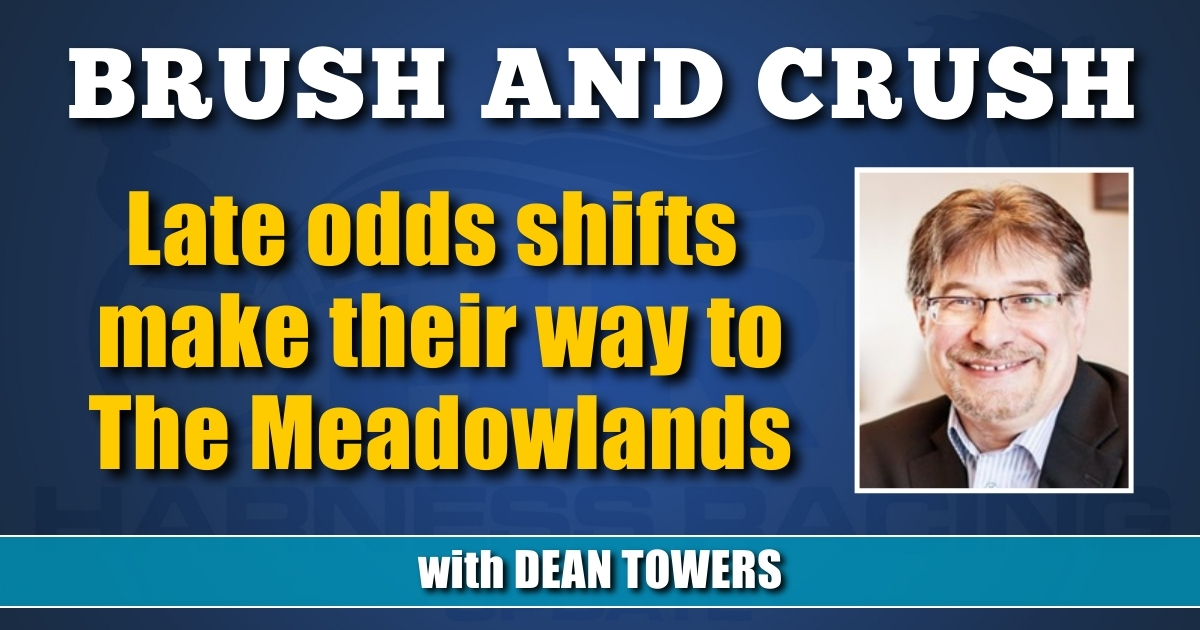
Late odds shifts make their way to The Meadowlands
by Dean Towers
The variance in the odds continues to frustrate customers. And the phenomenon is growing.
For those of us who wager on harness racing, wild late odds moves are nothing new.
Back in August at Woodbine Mohawk Park, the winner of the third race that no track handicapper even had on their radar moved from 5-1 to 2-1 last flash, causing fans to scratch their heads. A race later, another horse that track handicappers ignored, took ridiculous amounts of cash late and jogged at 4-5.
The night ended with yet another horse most figured as a contender, but took immense amounts of money, moving from 8-5 to 3-5 late.
It’s similar at Harrah’s Philadelphia and other venues.
One track we haven’t seen these types of betting patterns happen near as much is The Meadowlands; until last week that is.
Last Friday (Dec. 8) in an amateur race with many contenders, a horse moved from 8-5 to 4-5 late.
In the following race, the winner (who figured, but was 1 for 14 with seconditis), was hammered to 2-5, then went to 1-9 last flash.
In the third, recent Cullipher purchase New Rules went from 5-2 to even money last jump.
Later in the card, Whammer Jammer in another amateur race went from 7-5 to 1-2. Get Answers dropped from 6-5 to 1-2 and Good Deal from 8-5 to 4-5.
Beach Moment moved from 2-1 to 3-5, in one single last flash. Two races later, Springsteen went from even money to 1-5.
When Flirtin JK went to 1-9 on the last cycle, my phone pinged.
“You cannot make an assumption of final price unless you’re Carnac,” typed a seasoned, long-time harness player. “It’s making it impossible to play a horse that’s 5-1 or under because they can move three points on the bell. You simply cannot bet horses close to favorite when stupidity like this happens time and again.”
Why is this happening?
When complaints flew regarding the evening, I detailed above at Woodbine Mohawk Park, word down the grapevine was that these issues involved batch betting, and it does fit the mold.
“These divergences are most likely caused by multiple parties targeting a given horse and since it’s being bet in the gate, we can assume it’s computer assisted wagering or pro or semi-pro action,” said professional player and modeler Dennis Montero via direct message on X. “When the largest players [market makers] are trying to shape a price, it can go bad if everyone else is trying to do the same. This can happen frequently in a competitive pari-mutuel setting where you have a bunch of sharp action competing with each other.”
Some may call this “smart money” and frankly, it is. Horses that are dropping from 2-1 to 1-5 are probably a whole lot closer to an 83 per cent chance to win than a 33 per cent chance.
“These horses that are pounded to 1-5, 1-9, are typically strong bets,” Montero said. “They blindly return around $0.89 or $0.90 cents per dollar. It shows the wisdom of the crowds. So even if 6-5 is the fair price according to a model, 1-5 might actually be the true fair price after all the participants have voted.”
Although this happens in thoroughbred racing, it’s not as pronounced as it is in harness. Smaller pools are likely one culprit, but in my view it’s also this sport’s lack of field depth. Fifteen years ago, a 40 claimer at The Big M could have eight contenders; now most fields on a given night can be whittled down to two or three.
The condition sheets at places like Yonkers, Mohawk and Harrah’s Philadelphia are probably no help either. Horses dropping in class are generally good bets and when it’s their turn to win, everyone knows.
A solution to this problem — even if there is one — would probably involve the entire sport. And, as we all know, this business doesn’t work together very well.
But make no mistake, massive late odds shifts are not just complaints from grumpy bettors or something that fades away by next month. It’s a problem that’s real and growing.













